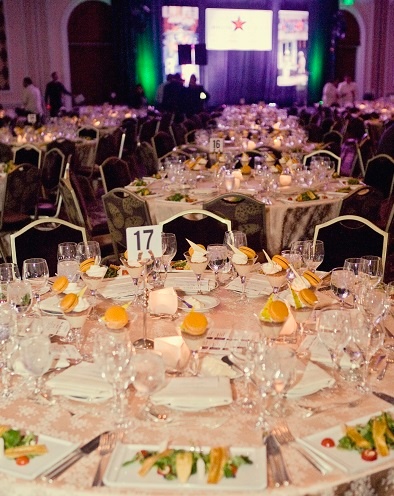When you think of putting on the annual charity auction, 5K Fun Run, golf tournament and more, do you get excited?
Or are you more like one organizer who described it like this: “I feel like someone emptied a jigsaw puzzle on top of my desk and now expects me to put it together – without the box.”
Fact is, the number one reason events don’t reach their full potential is that most event organizers simply don’t know what they don’t know. We tend to do events the same way they’ve been done – and make the same mistakes – for years, until the event is difficult to justify having at all.
That’s why at Winspire we’re passionate about providing resources, tips and ideas from event fundraising leaders across North America to help you reach and exceed your fundraising goals.
In today’s post we sat down with Noah McMahon, founder and CEO of a company that specializes in putting together multi-million dollar fundraising events and philanthropic consulting. Drawing from decades of event production experience, McMahon shares 5 useful event planning tips, including how to:
- Surprise the audience.
- Focus on face-to-face invitations.
- Combat the “table sale” bystander effect by setting expectations in advance.
- Set (and write down) BIG goals.
- Commit to measuring impact.
Best of all, each tip can be applied to fundraisers big and small. Let’s get started!
1. Surprise the audience.
“I have rarely been involved in events where you can send out invitations, sit back and all the seats get sold. So I like to focus on ‘event architecture’ when designing an event,” McMahon says.
The first step to selling tickets and generating buzz for your event, is to create someting that’s different and better than what people expect.
You already know your donors are busy people; Winspire surveys suggest the majority of winning bidders attend 4 or more philanthropic events each year. So “different” automatically tends to be more attractive.
Perhaps your guests are into food and wine. You might hold your event at a unique venue, like a farmhouse, and reach out to talent like celebrity chefs who can prepare a fresh local meal in front of your guests.

That’s not to say unique, unforgettable experiences are reserved for large organizations and big budgets.
“Just the other week I was helping with a gala related to eating healthy and exercise, and the apparel was workout attire,” McMahon says. “People came in workout clothes instead of black ties, and that was a blast. Everybody had fun, it was memorable, and most importantly, it was not expected.”
Studies show more and more people are looking to spend their money on experiences and not things. This not only makes experiential travel an enticing auction item, but unique experiences can start with the fundraising event itself.
Make it your goal to craft an event so appealing that tickets and registrations do sell out. Not only will you naturally sell more tickets, your event and cause will stay top of mind for years to come.
“Imagine what could happen if everyone who comes to the event has such a great time that they’re begging their friends to come the next time it happens,” McMahon says.
“We really need to focus on making experiences as wonderful as possible, because experiences are king.”
{{cta(‘bc4b315d-659b-4f3f-b7ab-190318c1f75a’,’justifycenter’)}}
2. Focus on face-to-face invitations.
Next, assuming registrations don’t all sell out in one go, try focusing on personal connections.
“Get face-to-face in front of as many of your donors as possible,” advises McMahon. “It’s best to do this if you have a compelling case that this event is worth attending; again, event design is key.”
While the most common forms of event promotion are printed flyers and email invitations, the #1 most effective method is word of mouth.
Being able to connect your event to a face makes word of mouth a powerful yet often underutilized tool in this day and age.
Along with inviting your personal networks, look into community events, festivals, sporting events and more that offer the opportunity to draw attention to your event. You might hand out flyers, host an informational table, or even request 30 seconds for a quick announcement about the event.
{{cta(‘856cb59f-7c2e-4d8a-99ed-f599a52fda93′,’justifycenter’)}}
3. Combat the downside of table sales by setting expectations in advance.

Table sales can be a double-edged sword for your event, and here’s why:
Event sponsors like the local car dealership, law office or dental firm may purchase a table at your event, but the guests filling those table seats aren’t necessarily going to be compelled to give further.
“The challenge I see is very often is that the tables are filled with support staff not interested in partipating at any monetary level,” McMahon says. “With the advent of social media, some guests will take a picture of themselves all dressed up and include a message that says, I’m proud to support this charity. The misnomer is that showing up and eating the chicken doesn’t mean you’re supporting the charity.
They’re just here for the free dinner.”
While it’s great to get the ticket revenue up front, that’s just not good enough, McMahon advises.
So how do we get around that? Set expectations early on, and keep the focus on fundraising.
Make sure the people who come to the event know financial support is expected. That’s not something to apologize for. Together with your team, come up with specific and intentional ways to demonstrate your charity’s impact throughout your promotional materials and the night’s agenda.
Remind guests they’re not only to fill the seats but support the cause.
“The charity is why we’re all there and that’s what we need to focus on.”
{{cta(‘f2a7ad66-bc37-4f6f-ac57-1560c652588b’,’justifycenter’)}}
4. Set (and write down) BIG goals.

We know the event budget is always a factor when it comes to setting goals for your event. So we asked McMahon, how can nonprofits think big, and how big should they think?
“You’re asking a dangerous person,” he says. “I recently listened to a book on tape called The Magic of Thinking BIG by David Schwartz. You only limit yourself by how you limit your thoughts. I would encourage anybody in the development field to read this book.”
One of the biggest mistakes in setting goals is when nonprofits don’t think big enough. So a rule of thumb McMahon follows is what’s called the ten times rule: Take your goal, then put a zero on the right side of it!
Whatever your goals are, multiply them by 10 and work 10 times harder to acheive those goals.
If you look at any truly successful organization in the nonprofit space and trace their success back to how it happened, it’s by people who worked their butts off and set goals much higher than they thought they could acheive.
The size of your success is only limited by the size of your thinking – just another reason to fill your committees with problem solvers and optimists.
Finally, it’s important to make sure your entire team is on the same page when coming up with goals for the event, so you’ll want to take the time to write down each goal.
Writing down 3 to 5 specific goals on a piece of paper and looking at it every time you meet, can be a powerful reminder of what’s at stake.
{{cta(‘32565c4f-0046-491a-8ce3-c0fddce3c63d’,’justifycenter’)}}
5. Commit to measuring and sharing impact.

In sports, we measure success by score and the record of wins versus losses. In school, we look at grades. In business, we look at profit.
From a philanthropic perspective, the amount of money given away is a far less important metric than the good or the impact that comes from that money.
In the development field, you need to point out to donors specifically what the impact is.
“It’s somewhat subjective because everybody cares about different aspects of your impact,” McMahon says. That’s why having a lot of money is not enough to be a target donor. You need to find someone aligned with your shared values.”
If your event focuses on a specific type of impact, finding donors that care most about it can be a winning combination.
This week on Events with Benefits
Today’s post was just a taste of the information provided by Noah McMahon in the latest episode of our event fundraising podcast, Events with Benefits. Noah offers invaluable tips to set ambitious goals, establish the right mindset and build relationships with donors. Learn…
- How enduring relationships make event fundraising better
- Tips to keep the focus on fundraising at your event
- The importance of starting events with the end in mind
- How to neutralize the “Debbie Downers” on your event committees …and more!
Hit play below to listen to the 30-minute podcast (or click here to visit the full site).
Already heard the podcast? Looking for even more tips? Click below to access the entire Winspire webinar library. It’s full of FREE one-hour sessions designed to educate and inspire your fundraising team.
{{cta(‘2c2afed8-70df-494b-8204-3eb3c111af11′,’justifycenter’)}}

